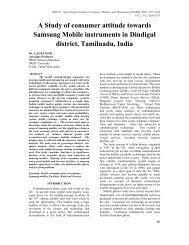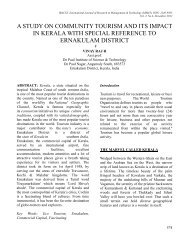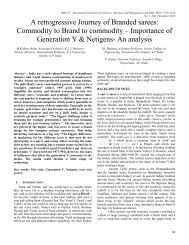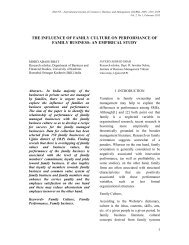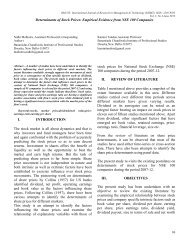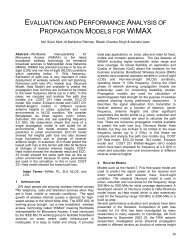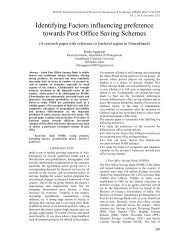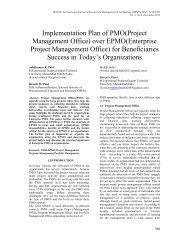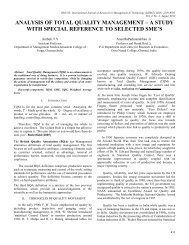Human Reliability Analysis: A review of the state of the art
Human Reliability Analysis: A review of the state of the art
Human Reliability Analysis: A review of the state of the art
You also want an ePaper? Increase the reach of your titles
YUMPU automatically turns print PDFs into web optimized ePapers that Google loves.
an assessment <strong>of</strong> given control mode, as highlighted by figures<br />
provided in table below (Tab.1). As can be seen by contents <strong>of</strong><br />
table, each <strong>of</strong> specified control modes has an individual<br />
reliability level. In extended CREAM version, control modes<br />
play <strong>the</strong> role <strong>of</strong> a weighting factor which scales a nominal<br />
failure probability associated to a given cognitive function<br />
failure. This version <strong>of</strong> CREAM is intended to be used for<br />
purposes <strong>of</strong> a more in depth analysis <strong>of</strong> human interactions.<br />
TABLE I.<br />
Control mode<br />
RELIABILITY INTERVAL<br />
<strong>Reliability</strong> Interval<br />
strategic 0.5 E-5 < p < 1.0 E-2<br />
tactical 1.0 E-3 < p < 1.0 E-1<br />
opportunistic 1.0 E-2 < p < 0.5 E-0<br />
scrambled 1.0 E-1 < p < 1.0 E-0<br />
2.Context description. The intention <strong>of</strong> basic CREAM<br />
method is to use it as a screening technique with <strong>the</strong> aim <strong>of</strong><br />
identifying processes which require a deeper level <strong>of</strong> analysis;<br />
this analysis may <strong>the</strong>n be carried out by <strong>the</strong> extended CREAM<br />
method.<br />
3.Specification <strong>of</strong> Initiating Events. When using basic<br />
CREAM method, a task analysis is conducted prior to fur<strong>the</strong>r<br />
assessment. CPCs are assessed according to descriptors, given<br />
in <strong>the</strong> table below (Tab.2), in order to judge <strong>the</strong>ir expected<br />
effect on performance.<br />
TABLE 2.<br />
COMMON PERFORMANCE CONDITIONS (CPCS)<br />
CPC Descriptors Expected effect<br />
Adequacy <strong>of</strong> Very efficient Improved<br />
organisation<br />
Efficient Not significant<br />
Working<br />
conditions<br />
Adequacy <strong>of</strong><br />
MMI and<br />
operational<br />
support<br />
Availability<br />
<strong>of</strong><br />
procedures/<br />
Inefficient<br />
Deficient<br />
Advantageous<br />
Compatible<br />
Incompatible<br />
Supportive<br />
Adequate<br />
Tolerable<br />
Inappropriate<br />
Appropriate<br />
IRACST- International Journal <strong>of</strong> Research in Management & Technology (IJRMT), ISSN: 2249-9563<br />
Vol. 2, No. 1, 2012<br />
CPC Descriptors Expected effect<br />
plans<br />
Reduced<br />
Reduced<br />
Improved<br />
Not significant<br />
Reduced<br />
Improved<br />
Not significant<br />
Not significant<br />
Reduced<br />
Improved<br />
Number <strong>of</strong><br />
simultaneous<br />
goals<br />
Accettable<br />
Inappropriate<br />
Fewer than capacity<br />
Matching current<br />
capacity<br />
More than capacity<br />
Not significant<br />
Reduced<br />
Not significant<br />
Not significant<br />
Reduced<br />
Available Adequate<br />
Improved<br />
time<br />
Temporarily Not significant<br />
inadequate<br />
Continuously Reduced<br />
inadequate<br />
Time <strong>of</strong> day Day-time (adjusted) Not significant<br />
Adequacy <strong>of</strong><br />
training and<br />
expertise<br />
Crew<br />
collaboration<br />
quality<br />
Night-time<br />
(unadjusted)<br />
Adequate, high<br />
experience<br />
Adequate, limited<br />
experience<br />
Inadequate<br />
Very efficient<br />
Efficient<br />
Inefficient<br />
Deficient<br />
Reduced<br />
Improved<br />
Not significant<br />
Reduced<br />
Improved<br />
Not significant<br />
Not significant<br />
Reduced<br />
4.Error prediction. Assessments <strong>of</strong> <strong>the</strong> CPCs <strong>the</strong>n require to<br />
be adjusted according to some specified rules in order to take<br />
account <strong>of</strong> synergistic effects. Matrix above would be<br />
considered in <strong>the</strong> context <strong>of</strong> <strong>the</strong> situation under assessment and<br />
by this means <strong>the</strong> previously considered initiating events are<br />
<strong>review</strong>ed with respect to how <strong>the</strong>y could potentially lead to<br />
occurrence <strong>of</strong> an error. Rows <strong>of</strong> matrix identify <strong>the</strong> possible<br />
outcomes while <strong>the</strong> columns show <strong>the</strong> precursors. Analyst <strong>the</strong>n<br />
has task <strong>of</strong> identifying <strong>the</strong> columns for which all <strong>the</strong> rows have<br />
been similarly classified into <strong>the</strong> same group according to<br />
column headings. Predicting <strong>the</strong> possible outcomes for each <strong>of</strong><br />
rows should be done until <strong>the</strong>re are no remaining possible<br />
paths. Each <strong>of</strong> identified errors requires to be noted along with<br />
causes and <strong>the</strong> outcomes.<br />
5.Determination <strong>of</strong> control mode. Finally, a simple count is<br />
performed <strong>of</strong> <strong>the</strong> number <strong>of</strong> CPCs that are causing an<br />
improvement in reliability and those which are reducing it. On<br />
<strong>the</strong> basis <strong>of</strong> this number <strong>the</strong> probable control mode is<br />
determined.<br />
The main advantages <strong>of</strong> this methodology are: <strong>the</strong><br />
technique uses <strong>the</strong> same principles for retrospective and<br />
40



